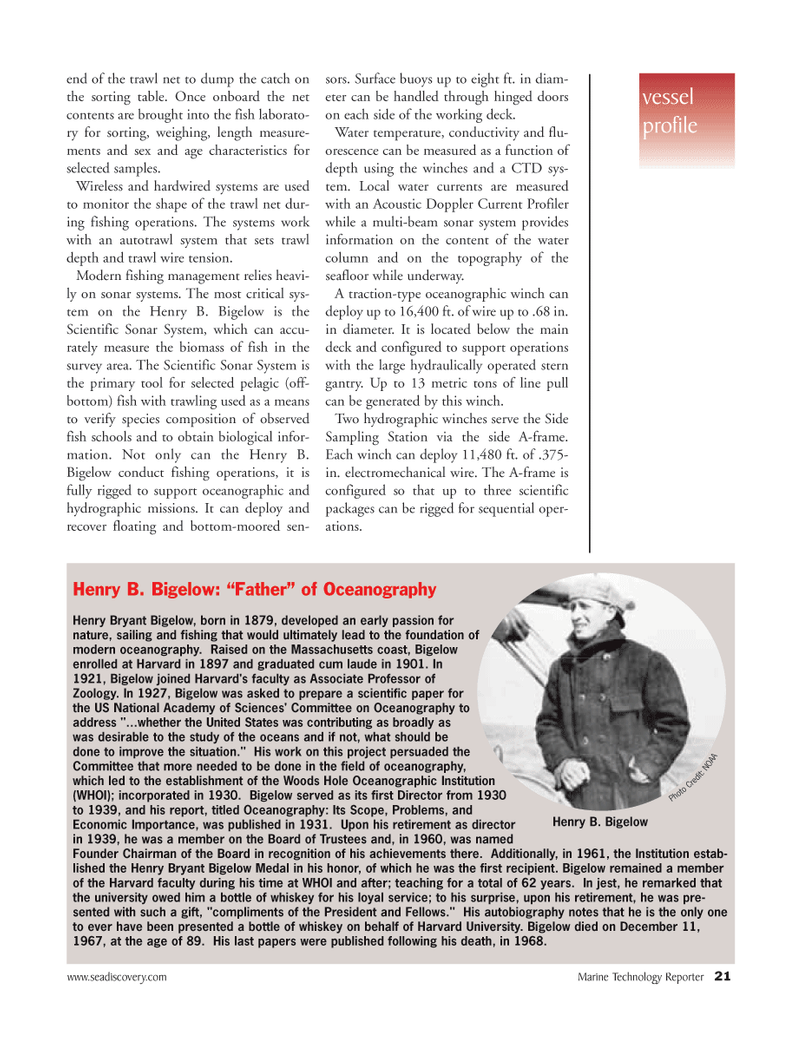
Page 21: of Marine Technology Magazine (November 2005)
Seafloor Engineering
Read this page in Pdf, Flash or Html5 edition of November 2005 Marine Technology Magazine
www.seadiscovery.com Marine Technology Reporter 21
Henry B. Bigelow: “Father” of Oceanography
Henry Bryant Bigelow, born in 1879, developed an early passion for nature, sailing and fishing that would ultimately lead to the foundation of modern oceanography. Raised on the Massachusetts coast, Bigelow enrolled at Harvard in 1897 and graduated cum laude in 1901. In 1921, Bigelow joined Harvard's faculty as Associate Professor of
Zoology. In 1927, Bigelow was asked to prepare a scientific paper for the US National Academy of Sciences' Committee on Oceanography to address "…whether the United States was contributing as broadly as was desirable to the study of the oceans and if not, what should be done to improve the situation." His work on this project persuaded the
Committee that more needed to be done in the field of oceanography, which led to the establishment of the Woods Hole Oceanographic Institution (WHOI); incorporated in 1930. Bigelow served as its first Director from 1930 to 1939, and his report, titled Oceanography: Its Scope, Problems, and
Economic Importance, was published in 1931. Upon his retirement as director in 1939, he was a member on the Board of Trustees and, in 1960, was named
Founder Chairman of the Board in recognition of his achievements there. Additionally, in 1961, the Institution estab- lished the Henry Bryant Bigelow Medal in his honor, of which he was the first recipient. Bigelow remained a member of the Harvard faculty during his time at WHOI and after; teaching for a total of 62 years. In jest, he remarked that the university owed him a bottle of whiskey for his loyal service; to his surprise, upon his retirement, he was pre- sented with such a gift, "compliments of the President and Fellows." His autobiography notes that he is the only one to ever have been presented a bottle of whiskey on behalf of Harvard University. Bigelow died on December 11, 1967, at the age of 89. His last papers were published following his death, in 1968. vessel profile end of the trawl net to dump the catch on the sorting table. Once onboard the net contents are brought into the fish laborato- ry for sorting, weighing, length measure- ments and sex and age characteristics for selected samples.
Wireless and hardwired systems are used to monitor the shape of the trawl net dur- ing fishing operations. The systems work with an autotrawl system that sets trawl depth and trawl wire tension.
Modern fishing management relies heavi- ly on sonar systems. The most critical sys- tem on the Henry B. Bigelow is the
Scientific Sonar System, which can accu- rately measure the biomass of fish in the survey area. The Scientific Sonar System is the primary tool for selected pelagic (off- bottom) fish with trawling used as a means to verify species composition of observed fish schools and to obtain biological infor- mation. Not only can the Henry B.
Bigelow conduct fishing operations, it is fully rigged to support oceanographic and hydrographic missions. It can deploy and recover floating and bottom-moored sen- sors. Surface buoys up to eight ft. in diam- eter can be handled through hinged doors on each side of the working deck.
Water temperature, conductivity and flu- orescence can be measured as a function of depth using the winches and a CTD sys- tem. Local water currents are measured with an Acoustic Doppler Current Profiler while a multi-beam sonar system provides information on the content of the water column and on the topography of the seafloor while underway.
A traction-type oceanographic winch can deploy up to 16,400 ft. of wire up to .68 in. in diameter. It is located below the main deck and configured to support operations with the large hydraulically operated stern gantry. Up to 13 metric tons of line pull can be generated by this winch.
Two hydrographic winches serve the Side
Sampling Station via the side A-frame.
Each winch can deploy 11,480 ft. of .375- in. electromechanical wire. The A-frame is configured so that up to three scientific packages can be rigged for sequential oper- ations.
Henry B. Bigelow
P h o t o
C r e d i t :
N
O
A
A
MTR#3 (17-32).qxd 11/14/2005 12:57 PM Page 21

 20
20

 22
22
